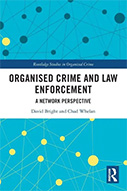Organised Crime and Law Enforcement: A Network Perspective

Authors: David Bright & Chad Whelan
Publisher: Routledge, 2021. 222 pages
Reviewer: Giulia Berlusconi | September 2022
Organised Crime and Law Enforcement: A Network Perspective by David Bright and Chat Whelan is an appealing read for those with an interest in the study of, and law enforcement responses to, organized crime. In the introduction, the authors suggest that the book is most suited for those who are less familiar with social network analysis, or those who are familiar with it but have used it in other fields. While the book mainly serves as a general introduction to various topics surrounding organized crime and its enforcement, the two-part structure ensures that readers, regardless of background, will discover new information and, possibly, new research ideas.
Students will find a brief, but informative, introduction to the network perspective as a way to better understand organized crime and law enforcement cooperation, as well as a comprehensive list of sources to expand their knowledge. Practitioners will find ideas on how to incorporate network concepts and techniques into their practice, and a discussion of common challenges that they may face when building and maintaining interorganizational networks. Finally, those who are already familiar with criminal networks scholarship will find a useful summary of existing knowledge and current debates surrounding the vulnerability and resilience of organized criminal groups, as well as insights into ways in which the network perspective can help to analyze law enforcement networks.
The first part of the book focuses on the benefits and challenges of adopting a network perspective in the study of organized crime. The authors begin with a discussion of various attempts to define organized crime, as well as the distinctions made between organized crime, criminal organizations, and criminal networks (Chapter 2). Students and those less familiar with organized crime research will likely go down the ‘rabbit hole’ of organized crime definitions.
Chapter 2 also includes a useful guide to navigate the various definitions of organized crime, and a convincing argument in favor of adopting a network perspective in order to analyze organized criminal groups. Following von Lampe’s (2015) example, the authors argue that a definition should be an outcome, rather than a prerequisite, of organized crime research. Adopting a network approach can facilitate this outcome by allowing scholars to ‘seek rather than assume’ the structure of an organized criminal group (Morselli, 2009). This is followed by an introduction to network theory and concepts that are relevant to the study of organized criminal groups (Chapter 3). While most literature goes straight to discussing metrics and measures (e.g., density, centrality), the authors also focus on key concepts that derive from network theory (e.g., embeddedness, homophily, multiplexity), and how they can be used to advance our understanding of criminal networks. This helps to bridge the gap between organized crime theory and network theory. Overall, the first two chapters provide a gentle introduction to organized crime research, social network theory and analysis, and set the scene for the remainder of the book.
The remaining two chapters in the first part of the book include a more focused discussion of the strengths and vulnerabilities of criminal networks (Chapter 4), and other factors that enable organized criminal groups to form and evolve over time (including convergence settings, mechanisms of trust formation, and the importance of local communities and kinship ties) (Chapter 5). The two chapters are closely intertwined, with several recurring concepts throughout. For example, trust is identified as a crucial element of criminal co-operation, as well as a constant challenge in illicit contexts. From a network perspective, the authors identify patterns of connections and social processes that can facilitate trust among the members of an organized criminal group, such as triadic closure. Again, the organized crime and social network analysis perspectives are nicely combined to provide a comprehensive overview of strengths and vulnerabilities of criminal networks.
Chapter 4 continues with a discussion of network resilience and the ways in which criminal networks balance the strengths and vulnerabilities presented earlier in the chapter. Here the authors make an interesting distinction between functional and structural resilience, in which the former refers to the ability of the network to perform its primary activities after either external or internal shocks, and the latter is the extent to which a network remains connected (even if it becomes non-functional). This distinction is often implied, but seldom explicitly addressed, in previous literature that often considers functional and structural resilience together, or structural resilience as the main focus. While the two are necessarily related, the authors’ choice to discuss them separately provides some clarity to the often-vague idea of ‘network resilience.’
The second part of the book focuses on law enforcement responses to organized crime. It focuses on a limited number of countries in North America, Europe, and Australia, and also draws on interviews conducted by the authors with law enforcement practitioners. Chapter 6 presents an overview of recent developments in the field, with a focus on the expanding reach of institutional responses (e.g., interorganisational networks), the increasing number of agencies tasked with the investigation and prevention of organized crimes, and the expanding set of tools and techniques that these agencies can utilize in attempts to prevent and disrupt organized crime (e.g., anti-money laundering legislation). The following chapters delve into more specific issues associated with the enforcement of organized crime from a network perspective.
Chapter 7 considers the idea of ‘disruption,’ and how social network analysis can help achieve disrupting organized criminal groups. The authors consider the distinction between disruption and eradication, noting how the former is representative of a more pragmatic position that acknowledges the difficulty in fully eradicating organized crime. While the authors hint at the possibility that disruption strategies might not be as effective as expected, or might have unintended consequences, more discussion of the potential limitations of current approaches, given the limited knowledge about how organized criminal groups respond to law enforcement targeting, may have been helpful.
The two final chapters consider interagency or interorganizational networks. The focus is, thus, shifted from networks of collaborating criminals to networks of agencies working together to prevent and disrupt organized crime. The chapters’ titles are quite vague in this part of the book, and their content might become clear only after reading them. Despite this, they include a very interesting discussion of how the network perspective is not only useful to study organized criminal groups, but also the agencies tasked with their enforcement.
Chapter 8 considers formal and informal networks in the field of law enforcement, and discusses their formation and evolution. Chapter 9, instead, focuses on various challenges that may arise when law enforcement agencies are asked to collaborate to tackle a common issue. Here, rather than helping to understand organized crime itself, some familiar network ideas and concepts (e.g., core-periphery, centralisation, brokers, structural holes) are used to help understand how law enforcement efforts can combat against organized crime. Trust is another recurring theme, as the authors consider the challenges associated with both interpersonal and interorganizational trust in the field of law enforcement cooperation. In addition to demonstrating the flexibility of the network approach, the authors highlight the importance of “draw[ing] more on the wider network literature when studying networks” (p. 210), as they incorporate insights from research in public administration and management into their discussion of interagency networks in law enforcement.
Throughout the book, the authors build a strong argument for adopting a network perspective to analyze and understand both organized crime and law enforcement responses to it. While no new research is presented, especially in the first part of the book, this is an important and timely endeavor that summarizes the growing body of literature on criminal and law enforcement networks, while also presenting it in an accessible format.
While the focus is specifically on organized crime, many of the ideas presented in the book can be easily transferred to other fields of inquiry. For example, network concepts and methods discussed in the first part of the book can be used to study other forms of co-offending that go beyond organized crime. Similarly, interagency networks are regularly established in criminal justice systems where multi-agency partnerships have become the norm. The authors’ call for adopting a network perspective that goes beyond metaphorical uses of the network concept, and instead incorporates concepts and measures from social network analysis literature, seems not only reasonable, but also well-grounded in existing criminal networks research.
References:
Moselli C. (2009). Inside criminal networks. New York: Springer.
von Lampe K. (2015). Organized crime: Analyzing illegal activities, criminal structures, and extra-legal governance. Thousand Oaks: SAGE Publications.
Giulia Berlusconi is a Lecturer in Criminology at TheUniversity of Surrey.


